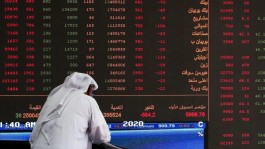The Saudi Tadawul All Share Index (TASI) recorded a notable decline, falling to 11,022.34 points, a loss of 0.7 percent during Wednesday's trading session. This continues a clear downward trend confirmed by several technical indicators. The decline follows a break below the important psychological support level of 11,000 points, a break that could trigger further selling pressure targeting the 10,860 area, a key support level used by traders when analyzing the index's movement.
This analysis was entirely extracted through the Analyze Chart feature available within the WarrenAI platform, which is now available with the Investing Pro subscription. It is an advanced feature that can analyze any chart with great accuracy based on actual data and trend and momentum indicators, making it one of the most effective professional tools that provides a quick and simplified view at the same time.
Analysis of the overall technical trend of the index
The index has continued its movement within a descending channel since October, and today it recorded a new low coinciding with the appearance of a bearish Marubozu candlestick, indicating strong selling pressure. The Relative Strength Index (RSI) is also showing at 30.78, a level close to oversold territory, which could potentially pave the way for a rebound. However, the absence of any clear reversal signal means the downtrend remains dominant for now.
The area between 10,860 and 10,910 is one of the most important potential rebound zones, as it is where the liquidity pivot point converges via the price volume indicator along with the 61.8 percent Fibonacci level, making this area a primary target for sellers or a suitable point for any technical rebound if an improvement in price behavior appears.
Expected downward scenario for the index
WarrenAI's analysis suggests that the bearish scenario is the most likely given the clear break below 11,000 and the continued strong negative momentum, coupled with the MACD and Super Trend indicators remaining firmly in a downtrend. This behavior opens the door for a move towards the first level at 10,908, with the possibility of further declines to 10,758 if selling pressure persists.
A daily close below the 11,000 level is a potential entry point for sellers according to technical criteria, while the stop loss is placed at 11,355. When the price reaches the first target, the analysis advises moving the stop loss to the entry point to protect the profit.
The bullish counter-trend scenario
Although the main trend remains downward, there is potential for a rebound near the 10,910 level, provided a strong reversal candlestick pattern emerges, confirming buyers' desire to regain some control. The forecast suggests a possible move towards 11,240 if the index manages to close above 11,074 daily; however, confidence in this scenario remains low due to the prevailing downward momentum.
Upon achieving the first objective in this scenario, it is advisable to secure half of the profits and move the stop loss to the entry point, to avoid any potential reversal that could strongly bring the negative momentum back to the market.
Sensitive areas and warning signs in the index movement
The area between 10,910 and 11,200 is currently considered unsuitable for trading due to high volatility and a weak risk-reward ratio. A sudden rise above 11,075 could also be a warning sign for sellers, as it might trigger a sudden influx of buying power due to what is known as a bear trap.
Trading volumes, however, remain below panic selling levels, an indication that the market may experience further declines before reaching a clear bottom area from which strong buying positions can be built.
Summary of daily analysis
The downward trend remains the dominant factor in the TASI's movement, and any potential rebound cannot be considered the start of a genuine trend reversal unless clear and strong confirmation emerges. The professional trader remains the one who monitors the most influential support levels and awaits the decisive signal before entering any trade.






































